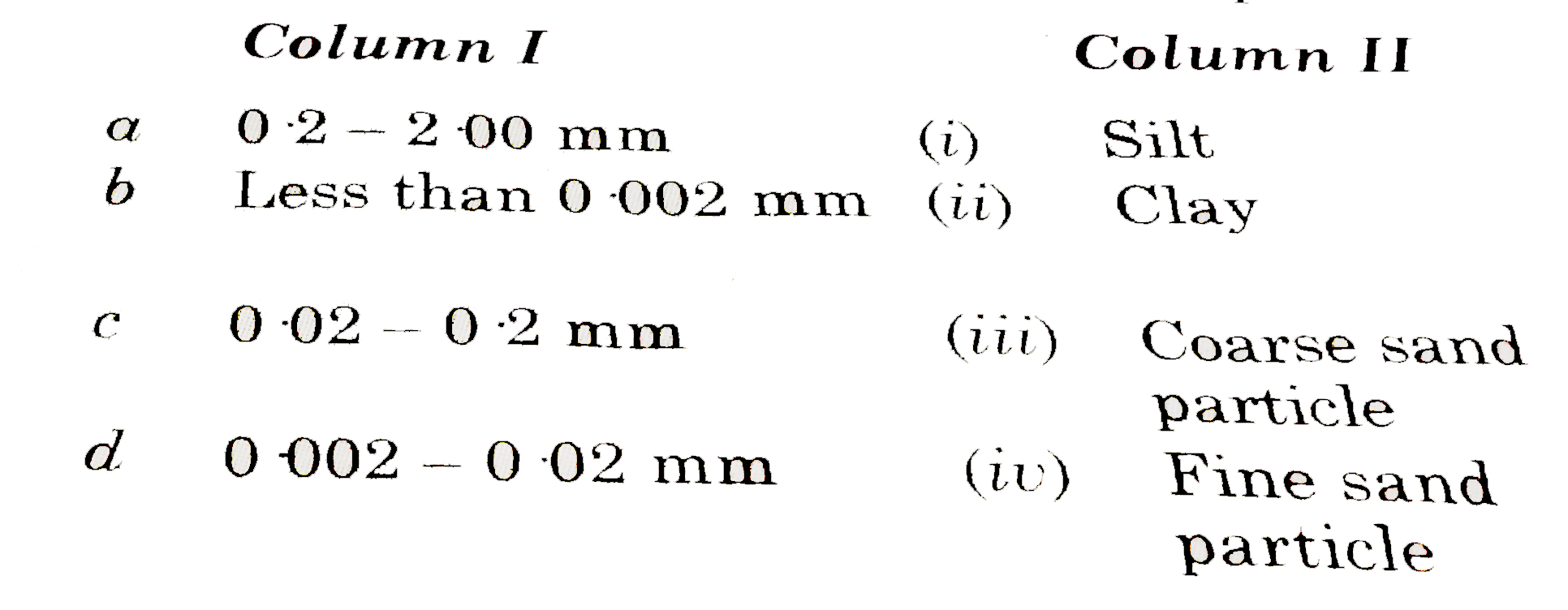Sand is not used to make vases because the soil particles are
Fine with air spaces
Large with air spaces
Fine and can retain. water
Large and can retain water
Step-by-Step Solution:
1. Understanding Sandy Soil:
- Sandy soil consists of large soil particles. This means that the individual grains of sand are bigger compared to other types of soil, such as clay.
2. Particle Size and Structure:
- The large size of the sand particles creates significant gaps or spaces between them. This structure is important because it affects how the soil behaves.
3. Air Spaces:
- Due to the large particle size, sandy soil has a lot of air spaces. This means that there is more oxygen present in the soil, which can be beneficial for some plants but not for making vases.
4. Water Retention:
- Sandy soil has low water retention capacity. This means that it does not hold water well, and water drains quickly through it. This is not ideal for creating vases, which need to retain moisture.
5. Lack of Stickiness:
- Because the particles in sandy soil are larger and less cohesive, they do not stick together well. This is in contrast to clay soil, which has very fine particles that can easily bind together.
6. Conclusion:
- For making vases, a material needs to be able to hold its shape and retain moisture. Sandy soil, with its large particles and air spaces, does not meet these requirements. Therefore, it is not suitable for making vases.
Final Answer:
Sand is not used to make vases because the soil particles are large with air spaces, which prevents them from sticking together and retaining water effectively.
---
- Sandy soil consists of large soil particles. This means that the individual grains of sand are bigger compared to other types of soil, such as clay.
- The large size of the sand particles creates significant gaps or spaces between them. This structure is important because it affects how the soil behaves.
- Due to the large particle size, sandy soil has a lot of air spaces. This means that there is more oxygen present in the soil, which can be beneficial for some plants but not for making vases.
- Sandy soil has low water retention capacity. This means that it does not hold water well, and water drains quickly through it. This is not ideal for creating vases, which need to retain moisture.
- Because the particles in sandy soil are larger and less cohesive, they do not stick together well. This is in contrast to clay soil, which has very fine particles that can easily bind together.
- For making vases, a material needs to be able to hold its shape and retain moisture. Sandy soil, with its large particles and air spaces, does not meet these requirements. Therefore, it is not suitable for making vases.
Sand is not used to make vases because the soil particles are large with air spaces, which prevents them from sticking together and retaining water effectively.
Topper's Solved these Questions
- SOILBOOK - BETOPPERSCHAPTER - SOILEXERCISE - CONCEPTIVE WORKSHEET
16 Videos
- SOILBOOK - BETOPPERSCHAPTER - SOILEXERCISE - SUMMATIVE WORKSHEET (MULTIPLE CHOICE QUESTION)
5 Videos
- OUR ENVIRONMENTBOOK - BETOPPERSCHAPTER - OUR ENVIRONMENTEXERCISE - SUMMATIVE WORKSHEET (ANSWER THE FOLLOWING QUESTIONS:)
24 Videos
- STRUCTURE AND FUNCTIONS OF PLANT PARTSBOOK - BETOPPERSCHAPTER - STRUCTURE AND FUNCTIONS OF PLANT PARTSEXERCISE - SUMMATIVE WORKSHEET (ODD ONE OUT)
5 Videos
Similar Questions
Knowledge Check
Silver is not used to make electric wires because
AIt is a bad conductor of electricityBIt is expensiveCIt is cheapDNone of the aboveAluminium is used for making alloys because of its
AResistance to corrosionBPoor conductivityCHeavinessDAll of theseMatch the columns of size with soil particles
 Aa-iv, b-I, c-iii, d-iiBa-iii, b-ii, c-iv,d-iCa-ii, b-iii, c-iv, d-iDNone of the above.
Aa-iv, b-I, c-iii, d-iiBa-iii, b-ii, c-iv,d-iCa-ii, b-iii, c-iv, d-iDNone of the above.
Water tightly held to soil particles is
View SolutionA certain soil type contains soil particles that are very large in size when compared to the soil particles of other soil types. The described soil is identified to be
View SolutionSoft iron is used for making electromagnet because it
View SolutionSoil particles determine its
View SolutionWater enters into the root hair from the soil in its normal condition because the osmotic pressure of the soil solution
View Solution
